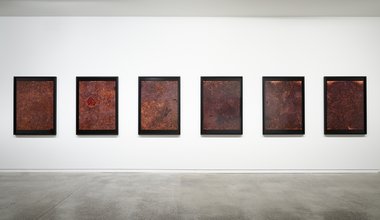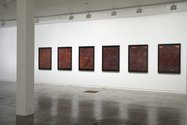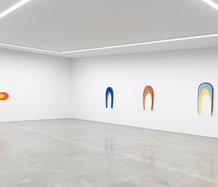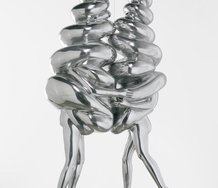John Hurrell – 28 November, 2019
Noble's spatially intriguing, highly textured, images are not made using light at all, but chemical traces present in the earth. They are greyish burnt-sienna fields that vaguely look like leaf litter peppered with scattered ash, interspersed with small black lakes that seem to come from a topographic map. Around the edges of some of these tiny puddles are flares of glowing fluorescent orange, pale cadmium yellow, specks of lime green and grey, minute smudges of bright purple.
This suite of six cameraless photographs (part of a larger solo show downstairs in Two Rooms) was made by well known Wellington artist, Anne Noble, by burying a strip of unravelled film in the ground at night, in the upper layer of soil of a patch of Australian native bush—left for 330 hours in order to capture “some form of tree language.” Whatever her beliefs about arboreal communication, the burying of chemical-sensitive film she sees as a conceit—an elaborate metaphor—that is a way of examining the damage done to top soil in our planet’s (final?) Anthropocene era.
Noble’s spatially intriguing, highly textured, images are not made using light at all, but chemical traces present in the earth. They are greyish burnt-sienna fields that vaguely look like leaf litter peppered with scattered ash, interspersed with small black lakes that seem to come from a topographic map. Around the edges of some of these tiny puddles are flares of glowing fluorescent orange, pale cadmium yellow, specks of lime green and grey, minute smudges of bright purple.
If for your interpretation you are thinking of realistic imagery, Noble’s camera seems to be aimed skywards at a leafy canopy; or the opposite, down at an autumnal ground; or perhaps a sideways close inspection of tree bark? Not vertical but horizontal.
Mostly though, despite being barklike, they are akin to maps or aerial views of bare landscape. Like the Australian William Robinson’s paintings—or the works of New Zealander Barbara Tuck—they are spatially ambiguous.
It is important however to see Noble’s photographs directly—very close—in order to zero in on the delicacy of the detail, to appreciate the trope she is using. These shots of soil look fiery; the earth is smouldering. Our planet is on fire.
This is super subtle work and I must confess it took me a couple of ‘passes’ to get drawn in. Proximity is crucial for them to be understood. Parking yourself far away in the middle of the gallery floor is missing the point.
John Hurrell















 Advertising in this column
Advertising in this column Two Rooms presents a program of residencies and projects
Two Rooms presents a program of residencies and projects



This Discussion has 0 comments.
Comment
Participate
Register to Participate.
Sign in
Sign in to an existing account.